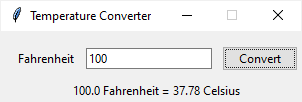Summary: in this tutorial, you’ll learn how to develop a full Tkinter object-oriented application.
You’ll convert the temperature converter application to a new one that uses object-oriented programming approach:

First, define a class called TemperatureConverter. The class has one static method that converts a temperature from Fahrenheit to Celsius:
import tkinter as tk
from tkinter import ttk
from tkinter.messagebox import showerror
class TemperatureConverter:
@staticmethod
def fahrenheit_to_celsius(f):
return (f - 32) * 5 / 9
Code language: Python (python)Second, define a ConverterFrame class that inherits from the ttk.Frame class. The ConverterFrame class will be responsible for creating widgets and handling events:
class ConverterFrame(ttk.Frame):
def __init__(self, container):
super().__init__(container)
# field options
options = {'padx': 5, 'pady': 5}
# temperature label
self.temperature_label = ttk.Label(self, text='Fahrenheit')
self.temperature_label.grid(column=0, row=0, sticky=tk.W, **options)
# temperature entry
self.temperature = tk.StringVar()
self.temperature_entry = ttk.Entry(self, textvariable=self.temperature)
self.temperature_entry.grid(column=1, row=0, **options)
self.temperature_entry.focus()
self.convert_button = ttk.Button(self, text='Convert')
self.convert_button['command'] = self.convert
self.convert_button.grid(column=2, row=0, sticky=tk.W, **options)
# result label
self.result_label = ttk.Label(self)
self.result_label.grid(row=1, columnspan=3, **options)
# add padding to the frame and show it
self.grid(padx=10, pady=10, sticky=tk.NSEW)
def convert(self):
""" Handle button click event
"""
try:
f = float(self.temperature.get())
c = TemperatureConverter.fahrenheit_to_celsius(f)
result = f'{f} Fahrenheit = {c:.2f} Celsius'
self.result_label.config(text=result)
except ValueError as error:
showerror(title='Error', message=error)
Code language: Python (python)How it works:
- The
ConverterFrameneeds a container, therefore, its__init__()method has thecontainerargument. - Inside the
__init__()method of theConverterCFrameclass, call the__init__()method of its superclass. - Assign the widgets to the
selfobject so that you can reference them in other methods of theConverterFrameclass. - Assign the
commandoption of theconvertbutton to theself.convertmethod.
Third, define an App class that inherits from the tk.Tk class:
class App(tk.Tk):
def __init__(self):
super().__init__()
self.title('Temperature Converter')
self.geometry('300x70')
self.resizable(False, False)Code language: Python (python)Finally, bootstrap the application from the if __name__ == "__main__" block:
if __name__ == "__main__":
app = App()
ConverterFrame(app)
app.mainloop()
Code language: Python (python)Put it all together:
import tkinter as tk
from tkinter import ttk
from tkinter.messagebox import showerror
class TemperatureConverter:
@staticmethod
def fahrenheit_to_celsius(f):
return (f - 32) * 5 / 9
class ConverterFrame(ttk.Frame):
def __init__(self, container):
super().__init__(container)
# field options
options = {'padx': 5, 'pady': 5}
# temperature label
self.temperature_label = ttk.Label(self, text='Fahrenheit')
self.temperature_label.grid(column=0, row=0, sticky=tk.W, **options)
# temperature entry
self.temperature = tk.StringVar()
self.temperature_entry = ttk.Entry(self, textvariable=self.temperature)
self.temperature_entry.grid(column=1, row=0, **options)
self.temperature_entry.focus()
self.convert_button = ttk.Button(self, text='Convert')
self.convert_button['command'] = self.convert
self.convert_button.grid(column=2, row=0, sticky=tk.W, **options)
# result label
self.result_label = ttk.Label(self)
self.result_label.grid(row=1, columnspan=3, **options)
# add padding to the frame and show it
self.grid(padx=10, pady=10, sticky=tk.NSEW)
def convert(self):
""" Handle button click event
"""
try:
f = float(self.temperature.get())
c = TemperatureConverter.fahrenheit_to_celsius(f)
result = f'{f} Fahrenheit = {c:.2f} Celsius'
self.result_label.config(text=result)
except ValueError as error:
showerror(title='Error', message=error)
class App(tk.Tk):
def __init__(self):
super().__init__()
self.title('Temperature Converter')
self.geometry('300x70')
self.resizable(False, False)
if __name__ == "__main__":
app = App()
ConverterFrame(app)
app.mainloop()
Code language: Python (python)In this tutorial, you have learned how to develop a full object-oriented Tkinter application.